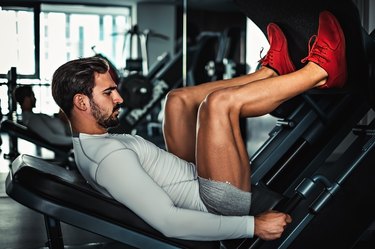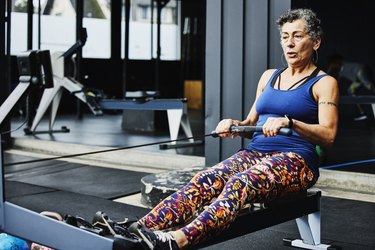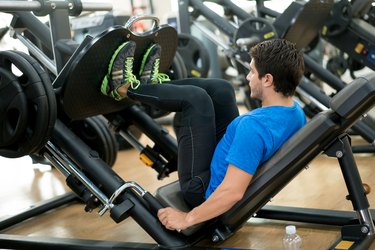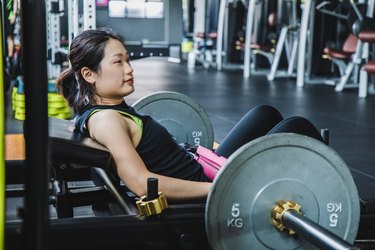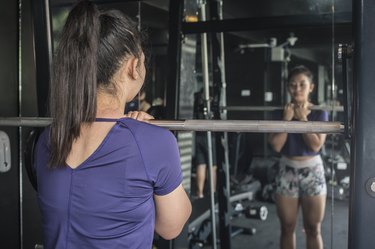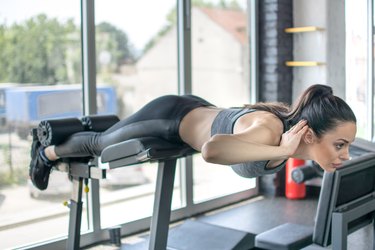Five Underrated Machines For Strong Lower-Body Lifts: Leg machines can help you build up the muscles in your lower body and hone in on your form to improve your lifts.
You don’t need to lift weights in order to perfect your form and increase the power of your lifts, whether you want to focus on your hip thrust or deadlift technique.
You can stress good form while enhancing strength, endurance, and explosiveness by using common lower body-focused training machines like the leg press and rower. If you want to lift heavier and more powerful weights, that last sentence is especially important.
Following are recommendations from experts on leg exercise machines that can enhance your lower-body lifts.
The Five Underrated Machines For Strong Lower-Body Lifts
1. Rowing Machine for Deadlifts
Although the rowing machine is frequently considered of as an exercise that focuses more on the upper body, it’s a fantastic way to supplement your deadlift training. According to Carlos Davila, CPT, an instructor at Fhitting Room, a HIIT and strength training gym in New York City and New Jersey, it strengthens the powerful hinging and driving through your legs that are essential for a good deadlift.
Because you push each stroke into your legs as you row, you press your feet firmly into the footpads. You pull the handle with your arms at the same time. Similar to a deadlift, you perform this movement by pressing your feet firmly into the ground and visualizing pushing the earth away from you as you lift the weight.
According to Davila, rowing also develops the lower body and posterior chain muscles that are necessary for deadlifting.
The ski erg machine, which simulates alpine skiing in real life, can be useful for deadlift training in addition to the rower.
“The ski erg teaches the hinge as well, with a focus on a forceful downward hinge (versus the explosive upward hinge used in the deadlift). It’s a great cardio machine for deadlift training because it works the quadriceps, glutes, hamstrings, back extensors, and abdominals “Says Davila.
How to Supplement Your Deadlift Training with Rowing
Row for brief periods. Eric Salvador, CPT, the chief instructor at the Fhitting Room, suggests, for instance, doing one minute of maximum-meter rowing followed by one-minute rest for five repetitions. “Sprinting quickly and hard improves power output. This is an excellent technique to convert deadlift improvements into rowing power.”
2. Seated Leg Press for Back Squats
According to Andrew Watkins, CPT, director of strength and conditioning at Sports Performance Lab, the seated leg press is a great exercise to improve your back squat technique since it teaches you to push evenly on your feet to focus your quadriceps or glutes.
“The leg press can relieve lower back tension so that the leg drive can be concentrated on. A person’s ability to squat is directly impacted by having stronger quadriceps and glutes, “He clarifies.
When performing a seated leg press, your back and hips should be flat against the seat, and you should brace your core while bending your knees to 90 degrees. You are using your legs to drive the weight by pressing your feet firmly against the platform. As a result, it mainly tones and develops your glutes and quads.
How to Improve Your Back Squats by Using the Seated Leg Press
By just shifting your foot position during the seated leg press, you can alter which muscle group you’re focusing on more.
“Learn how to make the most of the platform. It all boils down to being aware of your weaknesses. Do you believe your glutes should be stressed more or that your quads may be stronger? The way you plant your feet can make all the difference “states Watkins.
While maintaining a wider stance and pressing through the center of the footplate would work more of your quads, turning out your toes and placing your feet at the top of the platform will emphasize your glutes, according to Watkins.
3. Hip Thrust Machine for Barbell Hip Thrusts
Although not all gyms will have a hip thrust machine, using it can help you master the move without having to worry about keeping the barbell balanced on your hips. This makes it easier for you to concentrate on tightening your glutes at the peak of the exercise and carefully lowering your hips.
“Maintaining control throughout the range of motion, holding a strong contraction at the top, and lowering the pad gradually throughout the eccentric phase of the lift are essential for the hip thrust. This will guarantee the right tempo and produce effective effects. One can progress to barbell hip thrusts as they become more conscious of how to stimulate the right neural pathways and contract correctly “states Watkins.
How to Improve Your Barbell Hip Thrust Using the Hip Thrust Machine
The hip thrust machine configuration is essential for a successful lift. On the foot platform beneath your knees, you should have both flat feet. Be sure to brace your core and contract your glutes before starting the hip drive.
“By posteriorly rotating your hips and slightly contracting your abs, you can keep the spine in a firm, stable position as you go closer to the peak range of motion. Maintaining the chin slightly directed down is another teaching signal. As a result, you’ll be correctly braced and less likely to hyperextend your lower back “states Watkins.
You should halt when you reach the peak of the movement. According to him, doing so ensures that your glutes are loaded. After that, gradually bring your hips back down.
4. Smith Machine for Front Squats
For people who are injured or have restricted shoulder or wrist mobility, the Smith machine is a great substitute for a barbell front squat. However, it’s also a great resource for comprehending the front squat’s organic movement pattern.
Based on bar route and position, front squats are a more quad-dominant lift than back squats, according to Watkins. To keep the bar in place, it also engages parts of your upper-body muscles, including your trapezius and rhomboid (upper back muscles).
“Due to upper body breakdown or deficiencies, the majority of people struggle or even fail at this lift. The Smith machine excels in this situation because you can focus on leg drive, which allows you to grasp and feel the weight without having to pay as close attention to balance “states Watkins.
How to Boost Your Front Squat Performance with the Smith Machine
It can occasionally be unpleasant to perform front squats with the barbell in the front rack position with the bar resting over your shoulders.
“With less weight than a back squat, the Smith machine helps to simplify the workout and target weak quads. Always remember to engage your core and practice lowering yourself down slowly and deliberately. At the conclusion of each rep, pause momentarily before securely standing up “states Watkins.
5. Glute-Ham Developer for Squats and Deadlifts
The glute-ham developer, also referred to as the GHD, is one of the best lower-body exercise equipment for building strong glutes and hamstrings. As a result, it’s a fantastic tool for improving your deadlifts and squats.
According to Watkins, “the stronger we get in the posterior chain with good balancing points, the more efficient we may become overall.”
In particular for lower-body lifts that require you to bend at the waist, the GHD positions your body in a way that isolates your glutes and hamstrings and teaches you how to activate them.
Using this machine will help you develop the correct glute and hamstring contractions for heavy deadlifts and back squats so that your pelvis and lower back remain secure.


